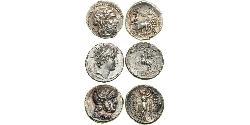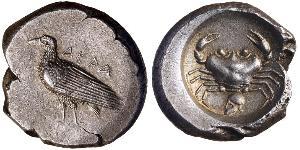1 Tetradramma
[ 2784] Kingdom of Syria Seleucid Kings, Seleukos I Nikator, 312-280 B.C. Silver Tetradrachm (17.12 gm). Susa, c. 305-294 BC. Head of Seleucus I right, wearing helmet covered with panther skin and adorned with bull's ears and horns, panther skin tied around neck, dotted border. / ΒΑΣΙΛΕΩΣ ΣEΛΕYKOY, Nike standing right, crowning trophy, monogram between. Reference: Hougton & Lober 173.4; Hoover 20; Newell, ESM 426. Attractively toned, with a particularly sharp reverse. Extremely fine. *Numismatic Note: Debate has long swirled regarding the identity of the 'helmeted hero' appearing on the obverse of this type - is it Seleucus I himself, or Alexander the Great, or a composite demigod incorporating features of Seleucus, Alexander and Dionysus? In the new Handbook of Syrian Coins (CNG, 2009), Oliver Hoover opts for identifying the portrait as an idealized image of Seleucus himself. Destined to be the longest-surviving of the 'Successors' of Alexander, Seleukos had a difficult time establishing his power. Alloted the satrapy of Babylon in 321 B.C. he was ousted from this position five years later, by Antigonos the One-eyed, and fled to his friend Ptolemy in Egypt. In 312 B.C. he regained Babylon and it is from this even that the Seleukid Era is dated. Seleukos gradually consolidated his power and in 305 B.C. took the title of King. From 305-3 he campaigned in the east, extending his rule as far as India. With his defeat of Lysimachos in 281 he became master of the whole of Alexander's empire, except Egypt; but the following year he was assassinated by Ptolemy Keraunos, a renegade son of his late friend, the King of Egypt. The territorial extent of this might realm varied greatly from period to period. At its zenith, under Seleukos I and Antiochos I, it compromised almost the whole of Alexander's conquests, except Egypt. In the mid-3rd century the easternmost provinces were lost when both Baktria and Parthia achieved independence. Antiochos III, the Great, attempted to regain the lost territories, but he was only partially successful and in 190 B.C. he was defeated by the Romans at the battle of Magnesia. This destroyed the Seleukid power in Asia Minor, their former possessions passed to Rome's ally, the Kingdom of Pergamon. The Seleukid Kingdom, now restricted to Syria and the surrounding area, maintained a precarious existence until 64 B.C. when it finally succumbed to Pompey the Great. Provided with certificate of authenticity. CERTIFIED AUTHENTIC by Sergey Nechayev, PhD - Numismatic Expert Payment & Shipping: Will accept payments via PayPal. About Seller: Dr. Sergey Nechayev is a Professor & international ancient coin expert and dealer. Participated in many international coin shows, including NYINC (New York International Numismatic Convention). All coins are provided with a certificate of authenticity based on many years of professional experience. All items are guaranteed genuine for a lifetime. Bid with confidence today! = MM_contentVersion;
}
else if (navigator.userAgent && navigator.userAgent.indexOf("MSIE")>=0 && (navigator.appVersion.indexOf("Win") != -1)) {
document.write('\n');
document.write('on error resume next\n');
document.write('MM_FlashCanPlay = ( IsObject(CreateObject("ShockwaveFlash.ShockwaveFlash." & MM_contentVersion)))\n\n');
}
if (MM_FlashCanPlay) {
document.write('');
document.write(' ');
document.write(' ');
document.write(' ');
document.write(' ');
document.write(' ');
document.write(' ');
document.write(' ');
document.write(' ');
document.write(' ');
document.write(' ');
}
else {
document.write(' ');
document.write(' ');
document.write(' This Vendio Gallery is best viewed with Macromedia Flash Player 6or higher. ');
document.write(' Click here to get the latestMacromedia Flash Player. ');
document.write(' ');
document.write(' ');
document.write(' ');
}
//--> Your browser does not support JavaScript. To view this page, enable JavaScript if it is disabled or upgrade your br ...
altro
Collezioni online di monete correlate

spa1 » Seleukid Empire (312 BC–63 BC) (16 monete)
Seleucid dynasty founded by Seleucus I Nicator following the division of the empire (Macedonia) created by Alexander the Great. Seleucus established himself in Babylon in 312 BC, the year used as the foundation date of the Seleucid Empire. T ...

spa1 » Nice Ancient Tetradrachms (33 monete)
Ancient Tetradrachms (Greece, Egypt, Syria, Sicily, Seleukid Kingdom, ...). Most of them couple hundreds years BC. Some of them are 2500+ years old. They have so good mining quality, sharp details and complicated compositions. Definitely anci ...

|
Postato da:
anonymous 2015-08-19 |
|
||
|
||
|
||
|
||
Queste monete potrebbero interessarti
2024-04-20
- New coin is added to 1/2 Pound Regno d'Inghilterra (927-1649,1660-1707) Oro Elisa ...
1/2 Pound Regno d'Inghilterra (927-1649,1660-1707) Oro Elisa ...
il gruppo ha 12 monete / 9 prezzi
⇑
Elizabeth I, second issue of crown gold, half pound, mm. coronet (1567-1570), broad bust, crowned bust l., rev. crowned shield of arms, ER at sides, wt. 5.48gms. (S.2520B; N.1994; Schneider 745), ...
2024-04-22
- Historical Coin Prices
Potresti essere interessato in…

-600-300-di4Kbzbiad8AAAFP0dir70Nf.jpg)

-300-150-5s4Kbzbi_YQAAAFLBcKgLg5u.jpg)
 English
English




-300-150-orHBwcI0ZxYAAAEoC2H7lKu1.jpg)







